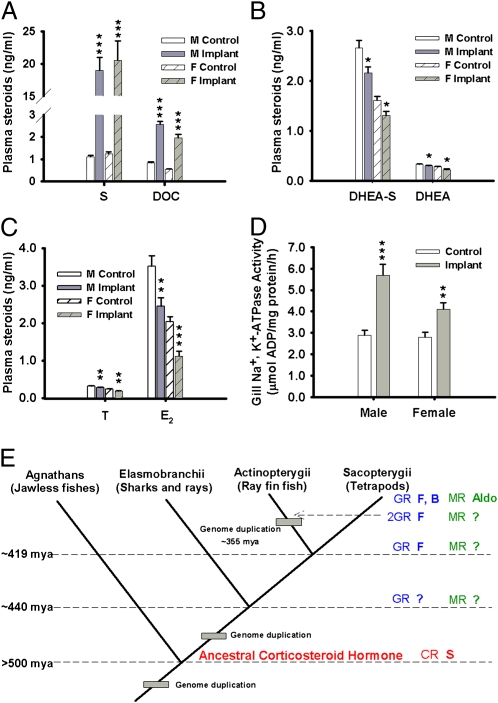Fig. 4.
Biological effects of 11-deoxycortisol implants. (A) Effect of 11-deoxycortisol treatment on plasma levels of 11-deoxycortisol (S) and 11-deoxycorticosterone (DOC) in male (n = 12/treatment) and female (n = 11–12) lampreys. (B) Effect of 11-deoxycortisol treatment on plasma levels of dehydroepiandrosterone-sulfate (DHEA-S) and dehydroepiandrosterone (DHEA) in male and female lampreys. (C) Effect of 11-deoxycortisol treatment on plasma levels of testosterone (T) and estradiol (E2) in male and female lampreys. (D) Effect of 11-deoxycortisol treatment on gill Na+, K+-ATPase activity in male and female lampreys. (E) Evolution of corticosteroid hormones in vertebrates. Our findings indicate that 11-deoxycortisol evolved as a corticosteroid hormone in the earliest vertebrate, the sea lamprey. Diagram modified from Bury and Sturm (3) and Bridgham et al. (6). The ancient corticosteroid hormone functioned as both mineralocorticoid and glucocorticoid. Aldo, aldosterone; B, corticosterone; CR, corticosteroid receptor; F, cortisol; GR, glucocorticoid receptor; MR, mineralocorticoid receptor; S, 11-deoxycortisol. Results in A–D are mean ± SE. Asterisks indicate significant (*P < 0.05; **P < 0.01; ***P < 0.001; Student's t test) difference.

